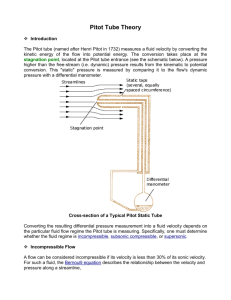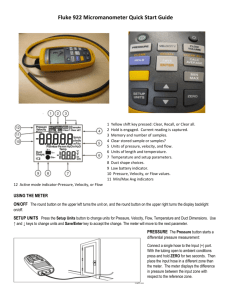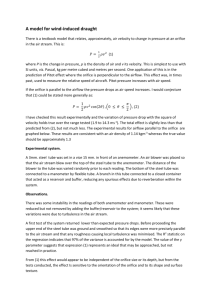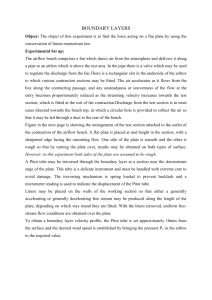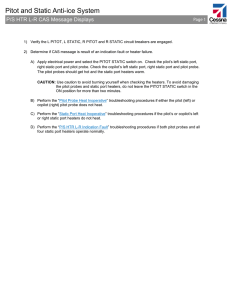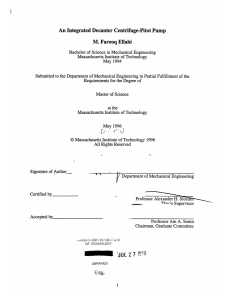Pitot Tube - Control Systems Laboratory
advertisement
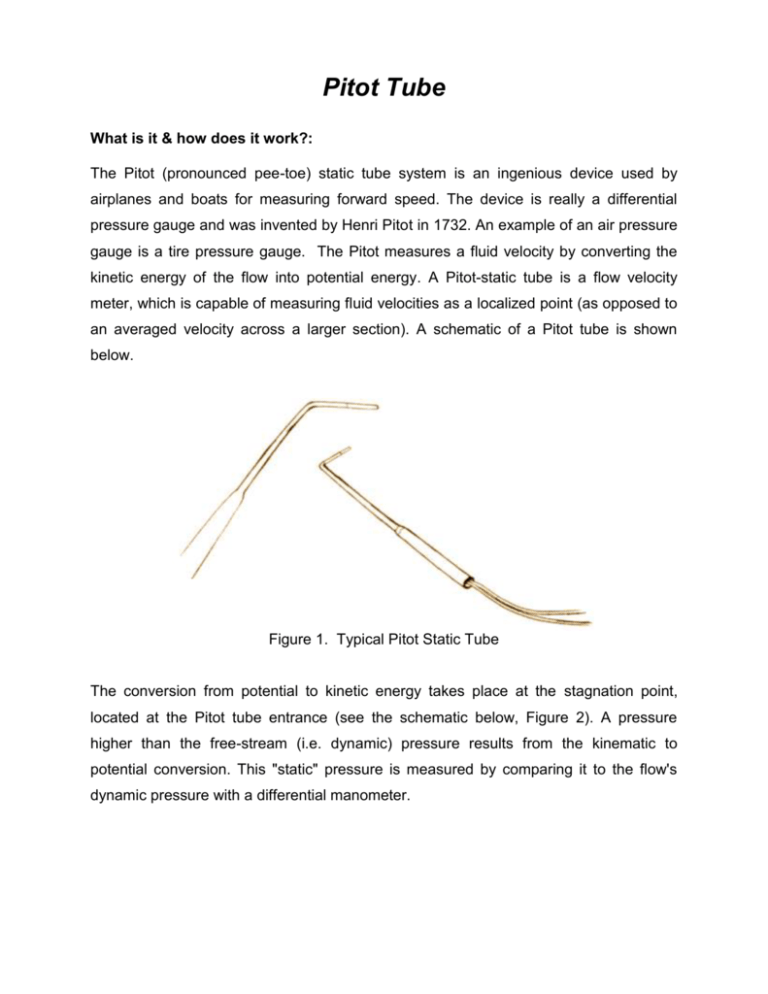
Pitot Tube What is it & how does it work?: The Pitot (pronounced pee-toe) static tube system is an ingenious device used by airplanes and boats for measuring forward speed. The device is really a differential pressure gauge and was invented by Henri Pitot in 1732. An example of an air pressure gauge is a tire pressure gauge. The Pitot measures a fluid velocity by converting the kinetic energy of the flow into potential energy. A Pitot-static tube is a flow velocity meter, which is capable of measuring fluid velocities as a localized point (as opposed to an averaged velocity across a larger section). A schematic of a Pitot tube is shown below. Figure 1. Typical Pitot Static Tube The conversion from potential to kinetic energy takes place at the stagnation point, located at the Pitot tube entrance (see the schematic below, Figure 2). A pressure higher than the free-stream (i.e. dynamic) pressure results from the kinematic to potential conversion. This "static" pressure is measured by comparing it to the flow's dynamic pressure with a differential manometer. Figure 2. Cross-section of a Typical Pitot Static Tube Converting the resulting differential pressure measurement into a fluid velocity depends on the particular fluid flow regime the Pitot tube is measuring. Specifically, for an incompressible flow, the Bernoulli equation describes the relationship between the velocity and pressure along a streamline, Figure 3. Generalization for calculating velocity using the Bernoulli equation Where it’s used: Hostile environments. e.g. flue stacks Combustion efficiency tests Research testing HVAC commissioning Heat exchanger balancing Process Control lines. Marine and aeronautical speedometers Calculating Error: When selecting a Pitot Static tube to be used in conjunction with any manometer, it is necessary to select a tube with a constant close to unity, if errors in velocity are to be avoided. If data for a particular Pitot tube is not available, the constant C may be estimated. This constant is dependent on the spacing of the Pitot tubes' static pressure ports (see Fig. 2) from the base of the Pitot tube's tip and the stem's center line. Prandtl type Pitot tubes typically have constants C close to 1. Figure 4 shows the effect and error of the location of the static pressure tappings on the static pressure error. Figure 4. Effect of static pressure hole location from Pitot Static Tube stem or tip The lower line gives the static pressure error associated with the distance of the static ports from the base of the tip, expressed in diameters. The upper line presents the static pressure error due to the distance of the static ports (expressed in diameters) from the stem center-line. Where can I get one, and how much is it?: www.infiltec.com MODEL DESCRIPTION PRICE Dwyer 6" Pitot Tube: use with micro-manometer for flow measurement in 166-6 small pipes and ducts. Comes with instructions and air density calculator. 5year warranty. $48 Dwyer 12" Pitot Tube: Use with micro-manometer for flow measurement in 166-12 larger pipes and ducts. Comes with instructions and air density calculator. 5year warranty. $49 DM1 Infiltec Digital Micro-Manometer: DM1 Specifications. Resolution of 0.1 Pa and 0.001" wc. Range ±750 Pa and ±3" wc. Pressure accuracy ±1% of reading or ±1 digit. Keypad selection of units (Pa or "wc”), time average, display zero, and on/off. Runs for at least 200 hours on one 9-volt alkaline $445 battery. Comes with calibration certificate, soft case, 9v battery, tubing & manual. Optional analog or serial output and battery eliminator available. 2-year warranty. Optional DM1 voltage output jack and plug. 0-5 volt signal, with 2.5 volts DM-A indicating zero pressure. This signal is independent of DM1 keypad settings for time averaging, units, and zero. $25 Optional DM1 serial output jack and cable with D9 connector. 9600-N81 pseudo RS232 ASCII records at 1 Hz rate terminated with LF&CR, 32000 to DM1-S -32000 values, resolution of 1/40 Pa, zero is set by keypad/display zero, keypad average has no effect. $35 DM1-P- Optional DM1 battery eliminator to replace 9V battery power. Plugs into 110 110 VAC /60 Hz. $25 www.professionalequipment.com HEAVY DUTY DIFFERENTIAL PRESSURE MANOMETER Our Item Number: HV3100 Manufacturer: EXTECH INSTRUMENTS Manufacturer Number: 407910 Your Price: $269.95 Wide Range dual input with multiple units and RS-232 interface Features & Applications: For the utmost precision in measuring positive, negative and differential pressure of air or natural gas, use our Heavy Duty Manometer with extreme confidence. Monitor and troubleshoot HVAC systems, and balance accurately. Checking for proper drafts, look for signs of increased radon risk-whatever your application-measurements can be taken in 8 different units of pressure. Features dual differential inputs with internal sensors, max/min, data hold, auto power-off, and a large LCD display. Equipped with metal input connections with two quick-disconnect fittings and a RS-232 PC interface. Features: Dual differential inputs with internal sensors Wide (±802 inches of water) measurement range with high resolution 8 display units of mbar, psi, kg/cm2, mmHg, inHg, mH2O, inH2O and atm Record Max and Min into memory for recall Data Hold and Auto Power Off Zero function for offset measurements Basic accuracy: ±1% of full scale (includes hysteresis) Large dual LCD display Metal input connections with two quick-disconnect fittings RS-232 PC interface and optional cable and software Includes 2 quick disconnect-fittings, 9V battery, and protective rubber holster with stand Applications: Air Natural gas Interface Options: Optional Windows® 95/98 compatible Data Acquisition Software and serial cable enable user to display and capture readings on a PC, and set time intervals and alarms. Detailed Specs: Specifications Range Resolution ±2,000 1 mbar ±29 0.02psi kg/cm2: ±2.040 0.00 1kg/cm2 mmHg: ±1,500 1 mmHg inHg: ±59.05 0.05 inHg mH2O: ±20.40 0.01 mH2O inH2O: ±802.0 0.5 inH2O atm: ±1.974 0.001 atm mbar: psi: Dimensions: Weight: 7x2.9x1.3”(178x74x33 mm) 12oz (350 g) References: http://www.efunda.com/designstandards/sensors/pitot_tubes/pitot_tubes_theory.cfm http://www.grc.nasa.gov/WWW/K-12/airplane/pitot.html http://www.davisontheweb.com/showl5.asp?L5ID=1&L4ID=1 http://www.professionalequipment.com/xq/ASP/ProductID.760/id.9/subID.186/qx/default .htm http://www.infiltec.com/inf-catb.htm#Pitot http://www.flowmeterdirectory.com/flowmeter_artc/flowmeter_artc_02111201.html

